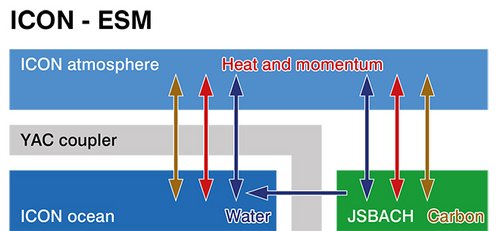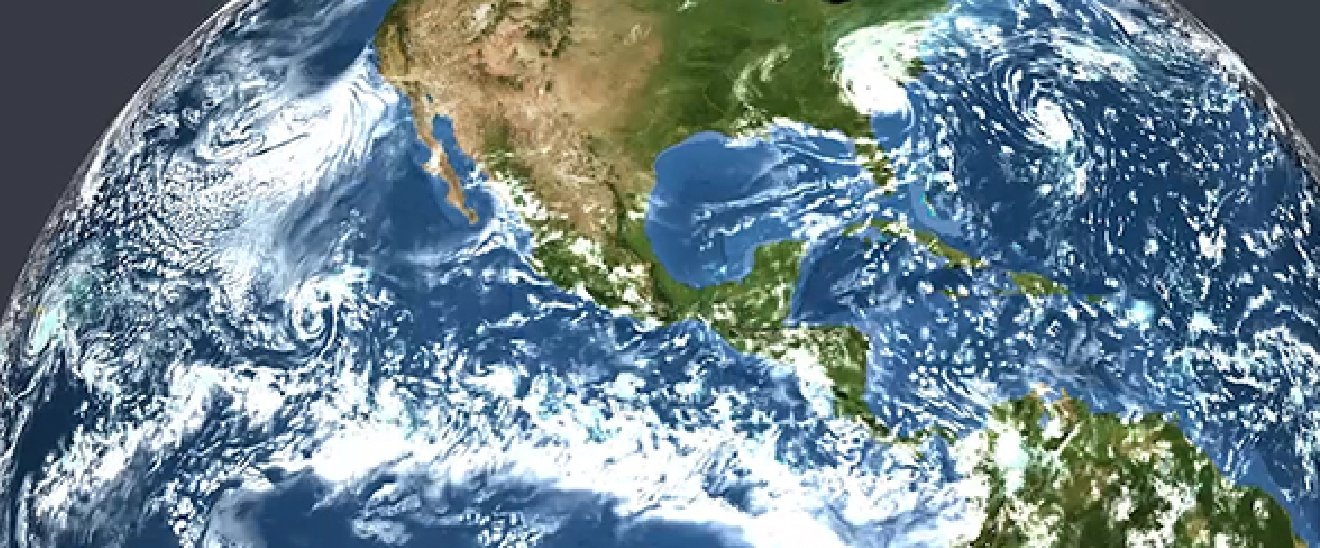ICON-ESM – MPI-M´s next-generation Earth system model
MPI-M´s new ICON Earth system model (ICON-ESM) is based on the circulation models ICON-A (for the atmosphere), ICON-O (for the ocean), and the land model ICON-L (also known as JSBACH), all developed in recent years. All of these models use icosahedral grids and the same software infrastructure.
The individually developed model components have begun to be run in a coupled fashion, thereby constituting the ICON-ESM. The first integration of ICON-ESM marks a milestone of paramount importance in the ICON project; a phase change from the development and application of single model components towards the application of the full model in climate research. The integration of the carbon cycle with its relevant biogeochemical processes is ongoing. Multi-century integration runs have already been made with the physical model under pre-industrial conditions. The grid spacing is at 160 km for the atmosphere and at 40 km for the ocean. The first simulation results reproduce main features of the climate system and are characterized by biases of similar magnitude as the predecessor MPI-ESM, but through the use of a much more scalable and flexible modelling framework.
Model components

The ICON-ESM combines the components ICON atmosphere, ICON ocean, ICON land (JSBACH4), a coupler and the carbon cycle model HAMOCC (fig. 1).
The components of the physical system exchange water, energy and momentum. Additionally, carbon is exchanged between the biogeochemical HAMOCC ocean model and the land biosphere via the atmospheric CO2 transport. The technical coupling to the ocean is effected by the means of the YAC couple.
ICON atmosphere (ICON-A)
The ICON atmosphere model was developed jointly with Germany's National Meteorological Service (Deutscher Wetterdienst, DWD) to create a common tool that is equally suitable for climate research and weather forecasting. ICON-A consists of the dynamical core solving the fully compressible equations and three different parameterization packages for different applications.
For fine-scale simulations, the large eddy resolving model ICON-LEM has been developed on the basis of idealized test cases, at resolutions down to 50 m, and later validated in large simulations covering the whole of Germany and using analysed boundary conditions and data from intensive observation campaigns. The second physics package originates from DWD and has been used at MPI-M for a number of idealized and realistic regional studies, as for instance the tropical Atlantic simulations made in a quasi-operational mode. This experiment used a domain extending from South America to central Africa with a resolution of 2.5 km and a nested region of 1.2 km resolution in the western portion. The third physics package applied in ICON-ESM originates from the ECHAM6 general circulation model and is suited for long-term simulations with lower resolution (Giorgetta et al., 2017; Crueger et al., 2017). This parameterization package has also been extended with a simple ozone chemistry scheme for studies with a focus on the tropopause region, and an interface to the comprehensive chemistry and microphysics model from the Karlsruhe Institute for Technology (KIT). For the interaction with the surface the ECHAM physics is coupled to the JSBACH4 land model and includes the interface to the YAC coupler, which mediates the exchange with the ICON ocean model.
ICON ocean (ICON-O)
The ocean component of ICON-ESM is the ICON ocean model (ICON-O; Korn and Danilov, 2017a; Korn, 2017b). It is based on the ocean primitive equations, as its predecessor MPI-OM in MPI-ESM. Two publications document the formulation of the dynamical core and a first evaluation of the model and discuss specific model properties. Presently, long-term stand-alone simulations are performed using OMIP forcing to document the results including a full oceanographic analysis. A performance analysis will be made that illustrates the computational efficiency which, in turn, will be important for future high-resolution modelling. With regard to functioning and complexity, ICON-O is by now comparable to MPI-OM.
The Hamburg Ocean Carbon Cycle Model (HAMOCC) was successfully transferred from the MPI-ESM ocean component to the ICON-ESM ocean component. It can both be run as a single component and in a coupled mode. The model encompasses marine carbonate chemistry, marine biogeochemistry, sea-air gas exchange, and a sediment module. It is part of the ICON-O implementation into ICON-ESM and its performance is currently being evaluated.
JSBACH land
The ICON land model JSBACH4 adopts a new and more advanced software infrastructure as compared to its predecessor JSBACH3, yet it maintains the same spectrum of processes plus land water from runoff and drainage to the ocean. The improvements comprise a hierarchical representation of land-surface characteristics and related processes, and a more flexible configuration. JSBACH4 can be used with both the ICON and as part of the older MPI-ESM. One completely new aspect of the JSBACH4 infrastructure is the representation of surface heterogeneity as a hierarchical tree of surface types (tiles), where each process is associated with specific sub-trees. It is possible to choose different configurations of varying complexity for the description of the land-surface characteristics and the processes that run on the respective tiles. This allows, for instance, to use simpler land processes to better match the needs of short-term high-resolution simulations, or more complex configurations suitable for long-term lower-resolution simulations with a focus on land processes and the carbon cycle.
The development of JSBACH4 is now at a stage where besides the fast processes from JSBACH3 (land physics and biology) also a first version of the natural land carbon cycle is implemented. The porting of the remaining processes from the predecessor (dynamic vegetation, land-use change, nitrogen) is under way.
YAC coupler
The software Yet Another Coupler (YAC) was developed in cooperation with the German Climate Computing Center (DKRZ) to accommodate the special needs of the ICON model (Hanke et al., 2016). YAC supports the unstructured grids used in ICON. The YAC coupler is used for the exchange of energy, momentum, water and important trace gases, and also fluxes and state information between the atmosphere, ocean and land model. An effective coupler allows for an efficient numerical data exchange, with the desired horizontal interpolation and temporal aggregation between the model components, which is demanding. YAC is a software framework that allows to easily add or replace algorithms in order to test new ideas and concepts. The YAC coupling software distinguishes itself by great adaptability: It offers flexible coupling of physical fields defined on different types of grids on the sphere without previous assumptions about grid structure or grid element types. All supported grids can be combined with any of the supported interpolations.
Coupled simulations with ICON-ESM
The first version of ICON-ESM runs at a 160 km grid resolution for atmosphere and land, with 47 atmospheric layers up to 80 km height and at 40 km resolution with 64 vertical layers for the ocean. The grid configuration is such that each atmosphere grid-box overlays 16 ocean grid cells (fig. 2). The ICON atmosphere model features a fractional land-sea mask with the land-sea mask determined by the finer ocean grid.
First multi-century simulations under pre-industrial conditions were made on the DKRZ high-performance computer, "MISTRAL". The present model configuration produces 45 simulation years per day on 60 nodes. Simulation results from this early stage of tuning reproduce the main features of the climate system and biases are similar to those from the well-established MPI-ESM in a comparable resolution (fig. 3).
While some deviations from the (late 20th century) observational data-base, such as the warm bias in the upwelling zones and the cold bias in the North Atlantic, are typical for coupled models, others, such as the overly warm Southern Ocean and the associated lack of Antarctic bottom water formation, or summer sea ice, are still a matter of investigation in the specific ICON-ESM set-up.
In the future we aim at high-resolution coupled configurations for both atmosphere and ocean, as well as performance gains that will increase the turnover time by a factor of two to four. For the eddy-resolving ocean we will apply a grid where the resolution scales with the local Rossbyradius in both hemispheres. Other configurations will feature regionally eddy resolving grids in the ocean and convection resolving grids in the atmosphere to study, for example, interactions between clouds and circulation, and ocean-atmosphere interactions in the tropical Atlantic. The flexibility and computational efficiency of the ICON modelling framework is opening new horizons for institute researchers.
Publications
Giorgetta, M. A., et al., 2017: ICON-A, the atmosphere component of the ICON Earth System Model. Part I: Model description, submitted to Journal of Advances in Modelling Earth Systems.
Crueger, T., et al., 2017: ICON-A, the atmosphere component of the ICON Earth System Model. Part 2: Model evaluation, submitted to Journal of Advances in Modelling Earth Systems.
Korn, P., and S. Danilov, 2017a: Elementary Dispersion analysis of some mimetic discretizations on triangular C-grid. J. Comp. Phys., 330, 156-172. doi: 10.1016/j.jcp.2016.10.059
Korn, P., 2017b: Formulation of an Unstructured Grid Model for Global Ocean Dynamics, J. Comp. Phys., 339, 525-552. doi: 10.1016/j.jcp.2017.03.009
Hanke, M., R. Redler, T. Holfeld, and M. Yastremsky, 2016: YAC 1.2.0: new aspects for coupling software in Earth system modeling. Geosci. Model Dev., 9, 2755-2769. doi: 10.5194/gmd-9-2755-2016
Contact
Dr Marco Giorgetta
Max Planck Institute for Meteorology
Phone: 040 41173 358
Email: marco.giorgetta@mpimet.mpg.de
Dr Peter Korn
Max Planck Institute for Meteorology
Phone: +40 40 41173 470
Email: peter.korn@mpimet.mpg.de
Dr Christian Reick
Max Planck Institute for Meteorology
Phone: +49 40 41173 117
Email: christian.reick@mpimet.mpg.de



